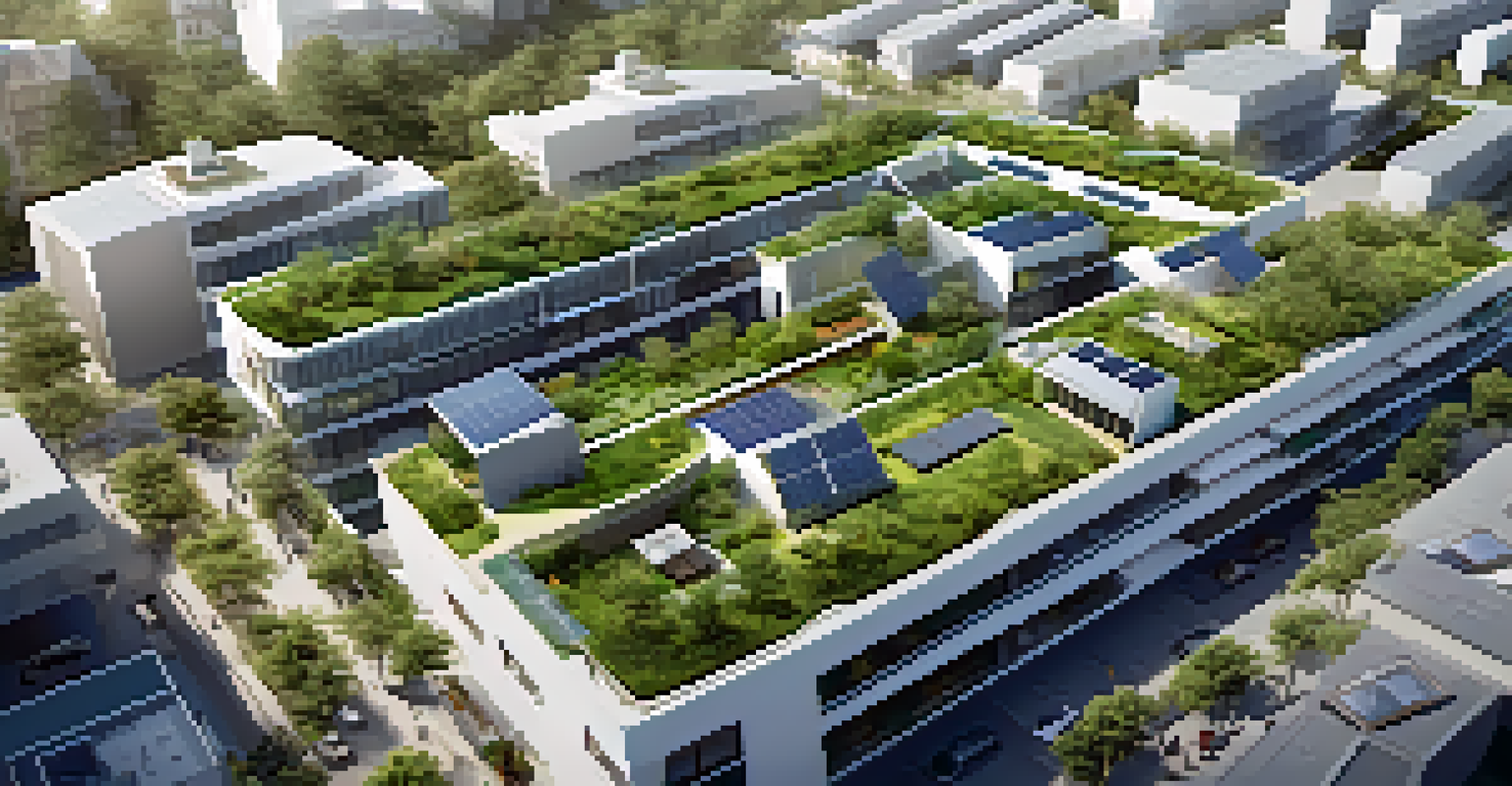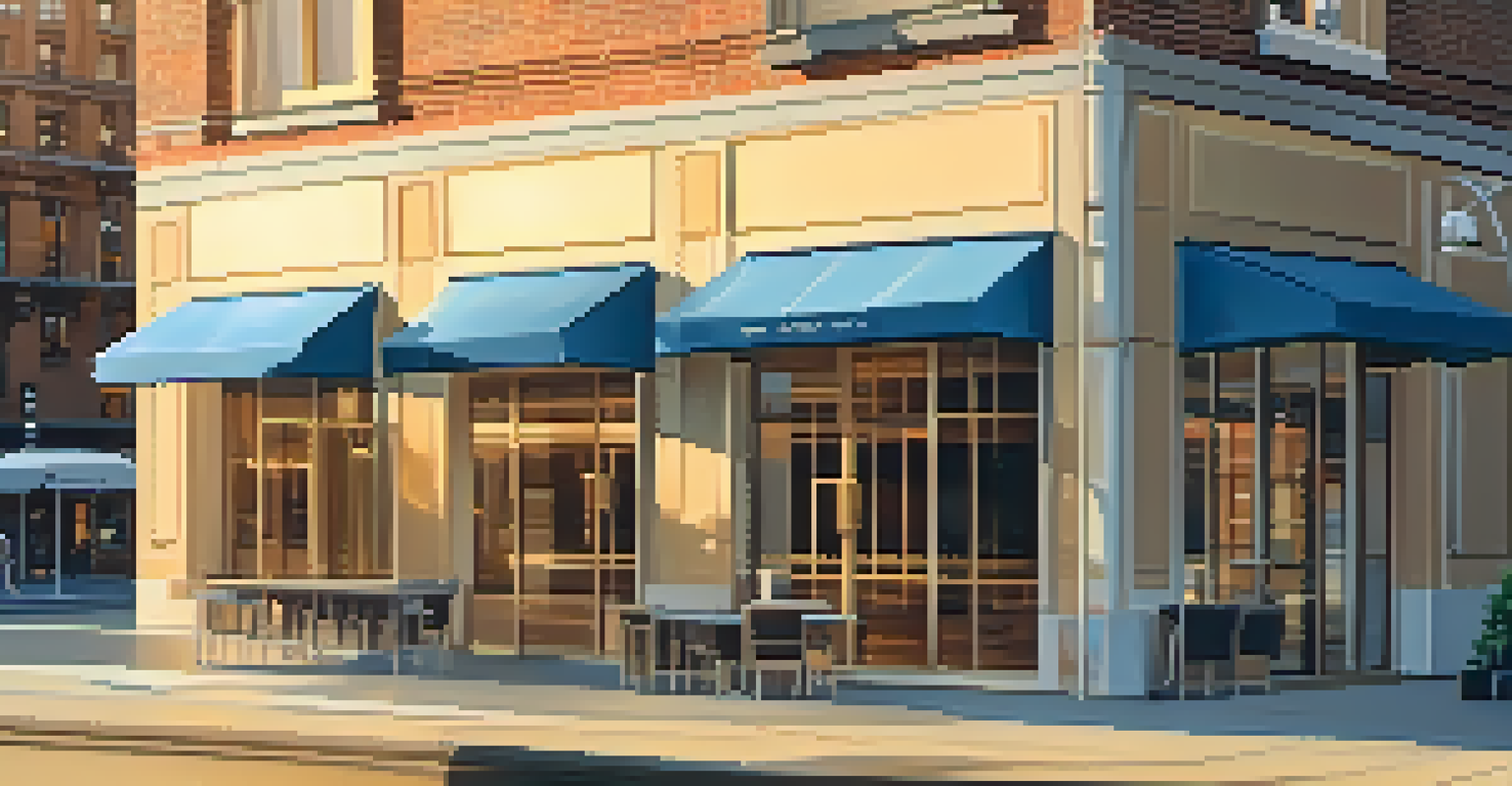The Impact of Building Orientation on Energy Efficiency Gains

Understanding Building Orientation and Its Importance
Building orientation refers to the direction a structure faces, which significantly impacts its energy performance. When architects consider orientation during the design phase, they can optimize natural daylight and minimize energy costs. For example, south-facing windows can capture sunlight during winter, reducing heating needs.
The sun is the ultimate source of energy for the Earth, and understanding how to harness it effectively can transform our approach to building design.
In contrast, poorly oriented buildings may experience excessive heat in summer, leading to higher cooling costs. This fundamental design choice can influence not just energy bills but also the comfort of occupants. Hence, understanding and applying the principles of building orientation is vital for sustainable architecture.
By strategically positioning a building, designers can harness the sun's path, wind patterns, and local climate conditions. This creates a win-win situation that benefits both the environment and the building's occupants, demonstrating that smart design choices lead to smarter energy use.
The Role of Sunlight in Energy Efficiency
Sunlight plays a crucial role in determining a building's energy efficiency. The amount and angle of sunlight can influence heating, cooling, and lighting requirements. For instance, rooms with large windows on the south side can utilize passive solar heating during colder months, reducing reliance on heating systems.

Conversely, excessive sunlight in warmer months can lead to overheating, requiring more air conditioning. Therefore, understanding how sunlight interacts with a building's orientation is essential for maximizing energy efficiency. Effective shading solutions, like overhangs or awnings, can mitigate these challenges.
Building Orientation Enhances Efficiency
Strategic building orientation optimizes natural light and reduces energy costs, significantly improving comfort and sustainability.
Ultimately, leveraging sunlight effectively not only cuts energy costs but also enhances the quality of indoor environments. Natural light can boost mood and productivity, showcasing how thoughtful design considerations translate into broader benefits for occupants.
Wind Direction and Its Effects on Energy Usage
Wind direction is another critical factor that impacts building orientation and energy efficiency. Buildings designed with wind flow in mind can benefit from natural ventilation, reducing the need for mechanical cooling systems. For example, strategically placed windows and vents can allow cool breezes to flow through, providing comfort without energy expenditure.
Good architecture is like good storytelling; it connects with its environment and the people who inhabit it.
If a building is poorly oriented against prevailing winds, it may become stuffy and require constant air conditioning. This not only drives up energy bills but may also decrease indoor air quality. Architects can enhance energy performance by considering local wind patterns during the design process.
Moreover, integrating landscaping elements like trees or shrubs can further enhance wind management. These natural features can act as windbreaks, helping to regulate the building's temperature and reduce energy consumption, making the property more sustainable.
Geographical Location and Climate Considerations
Geographical location and local climate are pivotal in determining the best orientation for energy efficiency. For instance, a building in a colder climate may benefit from maximizing south-facing surfaces, while one in a hotter climate might prioritize shading and ventilation. Tailoring orientation to these factors is essential for achieving optimal energy performance.
Additionally, climate zones can dictate the types of materials and insulation used. In warmer regions, reflective materials may help keep buildings cooler, while in colder areas, thermal mass materials can store heat effectively. This regional awareness can lead to smarter, more energy-efficient designs.
Sunlight and Wind Impact Energy Use
Understanding how sunlight and wind interact with a building's design is crucial for maximizing energy efficiency and indoor comfort.
Ultimately, understanding the interplay between orientation, climate, and location allows architects to create buildings that are not only energy-efficient but also more livable. This holistic approach contributes to sustainable living practices and reduces the overall carbon footprint.
The Benefits of Passive Solar Design
Passive solar design is an architectural approach that capitalizes on natural energy sources. By aligning buildings to maximize sunlight exposure and minimize heat loss, designers can significantly enhance energy efficiency. This method often reduces reliance on artificial heating and cooling, resulting in lower energy bills.
A classic example of passive solar design is the use of thermal mass, which stores heat during the day and releases it at night. Buildings that effectively incorporate these elements can maintain comfortable temperatures with minimal energy use. This approach not only benefits the environment but also creates a more comfortable living space.
Moreover, passive solar design encourages a more thoughtful relationship with the environment. It fosters awareness of how natural resources can be utilized effectively, promoting sustainable practices that benefit both people and the planet.
Incorporating Energy-Efficient Technologies
While building orientation is crucial, integrating energy-efficient technologies amplifies its benefits. For example, solar panels can be optimally positioned on roofs that face the right direction to capture maximum sunlight. This synergy between orientation and technology can lead to substantial energy savings.
Smart home systems further enhance efficiency by allowing homeowners to monitor and control energy use. Automated blinds can adjust to sunlight levels, while energy-efficient appliances reduce consumption. These technologies work best when paired with a well-oriented building, creating a comprehensive approach to energy management.
Passive Design Promotes Sustainability
Incorporating passive solar design principles allows buildings to utilize natural energy sources, leading to lower energy bills and a reduced carbon footprint.
Ultimately, the combination of strategic orientation and modern technologies creates a sustainable living environment. This integrated approach not only lowers energy costs but also supports a more environmentally friendly lifestyle, demonstrating the power of innovation in design.
Case Studies: Successful Orientation Practices
Looking at successful case studies can provide valuable insights into effective building orientation practices. For instance, the Bullitt Center in Seattle is designed to harness natural light and ventilation efficiently. Its orientation and design elements result in a building that generates more energy than it consumes, setting a benchmark for sustainability.
Another example is the Bosco Verticale in Milan, which incorporates vegetation on its balconies to enhance energy efficiency. This innovative design not only provides insulation but also improves air quality. Such projects highlight the diverse ways orientation can be utilized to achieve energy efficiency.

These case studies inspire architects and builders to consider orientation as a key factor in sustainable design. By learning from successful projects, the industry can continue to innovate and push the boundaries of energy-efficient construction.
Conclusion: The Future of Energy Efficiency and Building Design
As we look to the future, the importance of building orientation in energy efficiency cannot be overstated. With increasing energy costs and a growing emphasis on sustainability, architects and builders must prioritize this aspect in their designs. The integration of orientation with modern technologies offers a pathway to significant energy savings.
Moreover, educating clients and stakeholders about these practices can lead to more informed decisions. By embracing a holistic approach that considers orientation alongside innovative solutions, we can create buildings that are not only efficient but also contribute positively to the environment.
In conclusion, the marriage of thoughtful building orientation and energy-efficient technologies is crucial for a sustainable future. By prioritizing these practices, we can pave the way for greener buildings that enhance quality of life while reducing our ecological footprint.